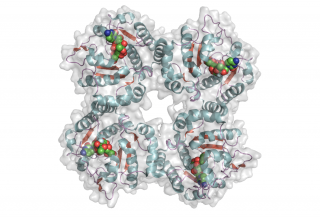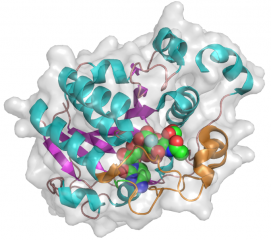CAZypedia needs your help! We have many unassigned GH, PL, CE, AA, GT, and CBM pages in need of Authors and Responsible Curators.
Scientists at all career stages, including students, are welcome to contribute to CAZypedia. Read more here, and in the 10th anniversary article in Glycobiology.
New to the CAZy classification? Read this first.
*
Consider attending the 15th Carbohydrate Bioengineering Meeting in Ghent, 5-8 May 2024.
Difference between revisions of "Glycosyltransferase Family 42"
| Line 52: | Line 52: | ||
The CjGT-42 enzymes Cst-I and Cst-II were the first sialyltransferases whose structure was determined by X-ray crystallography (Chiu et al. 2004), (Chiu et al. 2007), and they share the same basic structure. GT-42 enzymes have a modified GT-A type fold characterized by a single a/b Rossmann fold nucleotide binding domain, and a flexible lid domain composed of a coil and two helices (Fig. 10). | The CjGT-42 enzymes Cst-I and Cst-II were the first sialyltransferases whose structure was determined by X-ray crystallography (Chiu et al. 2004), (Chiu et al. 2007), and they share the same basic structure. GT-42 enzymes have a modified GT-A type fold characterized by a single a/b Rossmann fold nucleotide binding domain, and a flexible lid domain composed of a coil and two helices (Fig. 10). | ||
| − | <gallery widths=320px heights=240px perrow=2 caption="PDB ID 1RO8 from | + | <gallery widths=320px heights=240px perrow=2 caption="PDB ID 1RO8 from GT42 (click images for large versions)"> |
File:Cst II tetramer with ligand cmyk.png|top view | File:Cst II tetramer with ligand cmyk.png|top view | ||
| − | File:|side view | + | File:Cst II lid 3.png|side view |
</gallery> | </gallery> | ||
| − | + | ||
== References == | == References == | ||
Revision as of 08:06, 15 April 2010
This page is currently under construction. This means that the Responsible Curator has deemed that the page's content is not quite up to CAZypedia's standards for full public consumption. All information should be considered to be under revision and may be subject to major changes.
- Author: ^^^Warren Wakarchuk^^^
- Responsible Curator: ^^^Warren Wakarchuk^^^
| Glycosyltransferase Family GT42 | |
| Clan | GT-x |
| Mechanism | retaining/inverting |
| Active site residues | His188 is the catalytic base in the Campylobacter jejuni GT-42 known as Cst-II |
| CAZy DB link | |
| http://www.cazy.org/fam/GT42.html | |
Substrate specificities
The enzymes in GT-42 were originally examined from isolates of C. jejuni that express a number of ganglioside mimics, some of which have an a2,8-a2,3 linked di-sialic acid moiety [1]. The CjGT-42 known as Cst-II was found as part of the LOS biosynthesis operon [2], which facilitated the correlation of gene content to LOS structure. Based on the LOS structures which contained both a-2,3 and a-2,8 linked sialic acid it was predicted that there should be two sialyltransferases, but the surprising finding was that a single CjGT-42 enzyme, Cst-II, was making both linkages [3]. This bi-functional enzyme has been shown to be a determinant in the development of post-infectious neuropathies (Guillain-Barré syndrome), due to an anti-ganglioside antibody response in some patients who were infected with C. jejuni [4] [5]. Some species of Campylobacter express a second GT-42 enzyme known as Cst-I, which was in fact cloned first, but it has been shown not to be involved in LOS biosynthesis on the basis of gene knockouts in strains with both cst genes (Michel Gilbert, personal communication). Cst-I contains an extended C-terminal domain of unknown function, and the target acceptor of this second CjGT-42 is not known at present. The GT-42 family also contains members from H. influenzae and P. multocida, in which the GT-42 enzymes are one of two or three resident sialyltransferases. In H. influenzae the first GT-42 enzyme to be described was the a-2,3-sialyltransferase Lic3A (Hood et al. 2001), followed by a second a-2,3/2,8-bi-functional version known as Lic3B [6]. In H. influenzae the in vivo acceptor for Lic3A/B is the simple disaccharide lactose in contrast to the more complex ganglioside mimics seen in C. jejuni [7].
Kinetics and Mechanism
Detailed kinetic studies have revealed that this enzyme follows an unusual steady state iso ordered bi bi kinetic mechanism for carrying out sialyl transfer with inversion [8]. His188 appears to be the catalytic base, which is somewhat unusual since this role is generally performed by Glu or Asp residues. Direct measurement of its pKa by NMR showed the pKa agrees with that deduced from the pH dependence of this reaction. This required the generation of an active monomeric form of the tetrameric enzyme [8]. Chemical rescue of the H188A mutant was performed with nucleophilic anions adding weight to the assignment of the function, and further supporting the SN2-like inverting mechanism.
Catalytic Residues
His188 in CjGT-42 Cst-II from strain OH4383 appears to be the catalytic base.
Three-dimensional structures
The CjGT-42 enzymes Cst-I and Cst-II were the first sialyltransferases whose structure was determined by X-ray crystallography [9][10], and they share the same basic structure. GT-42 enzymes have a modified GT-A type fold characterized by a single a/b Rossmann fold nucleotide binding domain, and a flexible lid domain composed of a coil and two helices (Fig. 10). Unlike the typical GT-A fold, CjGT-42 enzymes lack the conserved DXD motif and are metal-ion independent. The enzyme structure revealed a tetramer (Fig. 8) in which each monomer carries an independent active site, and examination of the active site residues suggested a conserved histidine, His188 in Cst-II, as the catalytic base (Fig. 9)
Family Firsts
- First general acid/base residue identification
Cite some reference here, with a short (1-2 sentence) explanation
- First 3-D structure
The CjGT-42 enzymes Cst-I and Cst-II were the first sialyltransferases whose structure was determined by X-ray crystallography (Chiu et al. 2004), (Chiu et al. 2007), and they share the same basic structure. GT-42 enzymes have a modified GT-A type fold characterized by a single a/b Rossmann fold nucleotide binding domain, and a flexible lid domain composed of a coil and two helices (Fig. 10).
- PDB ID 1RO8 from GT42 (click images for large versions)
References
- Irving Nachamkin, Christine M. Szymanski, and Martin J. Blaser. (2008) Campylobacter. Amer Society for Microbiology.
- Gilbert M, Brisson JR, Karwaski MF, Michniewicz J, Cunningham AM, Wu Y, Young NM, and Wakarchuk WW. (2000). Biosynthesis of ganglioside mimics in Campylobacter jejuni OH4384. Identification of the glycosyltransferase genes, enzymatic synthesis of model compounds, and characterization of nanomole amounts by 600-mhz (1)h and (13)c NMR analysis. J Biol Chem. 2000;275(6):3896-906. DOI:10.1074/jbc.275.6.3896 |
- Gilbert M, Karwaski MF, Bernatchez S, Young NM, Taboada E, Michniewicz J, Cunningham AM, and Wakarchuk WW. (2002). The genetic bases for the variation in the lipo-oligosaccharide of the mucosal pathogen, Campylobacter jejuni. Biosynthesis of sialylated ganglioside mimics in the core oligosaccharide. J Biol Chem. 2002;277(1):327-37. DOI:10.1074/jbc.M108452200 |
- Koga M, Takahashi M, Masuda M, Hirata K, and Yuki N. (2005). Campylobacter gene polymorphism as a determinant of clinical features of Guillain-Barré syndrome. Neurology. 2005;65(9):1376-81. DOI:10.1212/01.wnl.0000176914.70893.14 |
- Chiu CP, Watts AG, Lairson LL, Gilbert M, Lim D, Wakarchuk WW, Withers SG, and Strynadka NC. (2004). Structural analysis of the sialyltransferase CstII from Campylobacter jejuni in complex with a substrate analog. Nat Struct Mol Biol. 2004;11(2):163-70. DOI:10.1038/nsmb720 |
- Chiu CP, Lairson LL, Gilbert M, Wakarchuk WW, Withers SG, and Strynadka NC. (2007). Structural analysis of the alpha-2,3-sialyltransferase Cst-I from Campylobacter jejuni in apo and substrate-analogue bound forms. Biochemistry. 2007;46(24):7196-204. DOI:10.1021/bi602543d |
- van Belkum A, van den Braak N, Godschalk P, Ang W, Jacobs B, Gilbert M, Wakarchuk W, Verbrugh H, and Endtz H. (2001). A Campylobacter jejuni gene associated with immune-mediated neuropathy. Nat Med. 2001;7(7):752-3. DOI:10.1038/89831 |
- Hood DW, Cox AD, Gilbert M, Makepeace K, Walsh S, Deadman ME, Cody A, Martin A, Månsson M, Schweda EK, Brisson JR, Richards JC, Moxon ER, and Wakarchuk WW. (2001). Identification of a lipopolysaccharide alpha-2,3-sialyltransferase from Haemophilus influenzae. Mol Microbiol. 2001;39(2):341-50. DOI:10.1046/j.1365-2958.2001.02204.x |
- Fox KL, Cox AD, Gilbert M, Wakarchuk WW, Li J, Makepeace K, Richards JC, Moxon ER, and Hood DW. (2006). Identification of a bifunctional lipopolysaccharide sialyltransferase in Haemophilus influenzae: incorporation of disialic acid. J Biol Chem. 2006;281(52):40024-32. DOI:10.1074/jbc.M602314200 |
- Schweda EK, Richards JC, Hood DW, and Moxon ER. (2007). Expression and structural diversity of the lipopolysaccharide of Haemophilus influenzae: implication in virulence. Int J Med Microbiol. 2007;297(5):297-306. DOI:10.1016/j.ijmm.2007.03.007 |
- Chan PH, Lairson LL, Lee HJ, Wakarchuk WW, Strynadka NC, Withers SG, and McIntosh LP. (2009). NMR spectroscopic characterization of the sialyltransferase CstII from Campylobacter jejuni: histidine 188 is the general base. Biochemistry. 2009;48(47):11220-30. DOI:10.1021/bi901606n |

